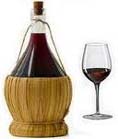Have You Heard Of
"Treen"?
from Italian Traditional Food
Treen is now collectable
Check out these great Italian ideas at Amazon for Italian food and kitchen ideas.
Many cooks not only enjoy the cooking itself, but also like to
collect useful and decorative objects to have about the kitchen. If you enjoy browsing through junk shops, there
are many fascinating things to find, especially in the field of treen.
The word "treen" is used to describe those small household objects
that are turned and carved from wood - from bobbins to butter pats and salt boxes to Welsh love spoons.
What is treen?
The pleasant thing about treen is that
it is largely a peasant art. Most of the implements belonged to kitchen, farm and cottage and were designed for use
rather than ornament, though ornamentation followed naturally as the scope and the skill of the woodcarver
grew. The charm of the early treen lies in the fact that no
two pieces were ever exactly alike and there is no hard and fast rule about dating these objects, though some
knowledge of contemporary styles in silver and pottery will help. The true
treen collector must be constantly amazed at the variety of things it is possible to find.
Some items, custom-made by cottage craftsmen, remain a puzzle as to what exactly they were for, the reason for
their use has passed - like so much of the early woodware - into the dust of ages.
Collect and use
However, there are still a good many identifiable objects worth
the search. Lemon squeezers, for example, all carved from close-grained hardwood - one 17th century type looks like
an outsize nutcracket.
Potato mashers, wooden spoons and steak beaters still follow the
traditional pattern, and are still made of best quality beechwood. Sycamore is another harw wood often used for
chopping boards and bread boards. Look out, too, for double egg cups of different sizes joined base to base. The
larger size was for a duck's egg, while the smaller one took a hen's egg. There are grounds, though, for believing
that the larger ones are not egg cups at all, but old "dry" or spice measures used in grocery shops.
Butter prints, too, often beautifully decorated, are to be found
in country districts, as are cheese moulds. These look like an ordinary bowl, but have straight sides and "weep"
holes for the cheese near the edges.
You might find a salt box, straight-sided and possibly with the
original leather hinges. But if the box is tall and looks like a child's pencil box standing on its end, it will be
a candle cox. The earliest recorded use of mahogany in this country was in fact for one of these.
Folk lore
Though candle boxes have gone out of use, egg timers haven't. Hour
glasses, too, can still be found in antique shops, though they tend to be expensive. Wooden spoon racks are useful
as well as ornamental, and some have a cutlery drawer below. Seventeenth-century ones had pierced ledges to hold
the spoons, wheras later ones usually had notches instead.
And Welsh love spoons? It was the custom for a man to announce his
intention to court a lady by presenting her with a spoon, carved of course from a single piece of wood and
decorated with love tokens to the best of his carving ability (hence the origination of the term "spooning"). A
flighty lady could collect quite a few fine specimens before committing herself.
Nutcrackers, trivets, spice mills, drinking vessels and trenchers
- all these can be yours once you become fscinated by the beauty of wood, the skill of the carver and a slice or
two of domestic history.
Read more Italian Traditional Food related articles here

Copyright © 2009 - . All Rights Reserved
Worldwide. Italian Traditional Food
You may not reprint articles from this website
without the written permission of the site owner.
Disclaimer: Articles on this
Website are provided for information purposes only. Italiantraditionalfood.com does not accept any responsibility
or liability for the use or misuse of the article content on this site or reliance by any person on the site's
contents.
| 


 Digg
Digg Stumbleupon
Stumbleupon Google Bookmarks
Google Bookmarks Delicious
Delicious Twitter
Twitter Facebook
Facebook Yahoo My Web
Yahoo My Web Reddit
Reddit